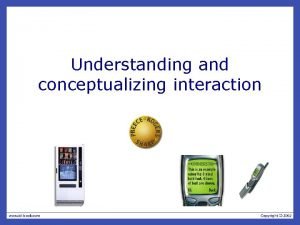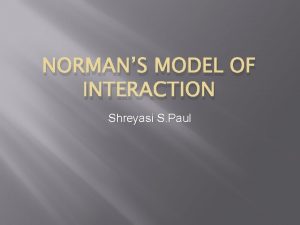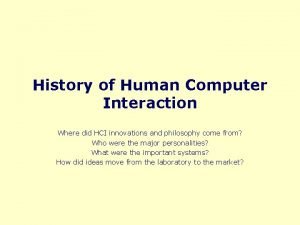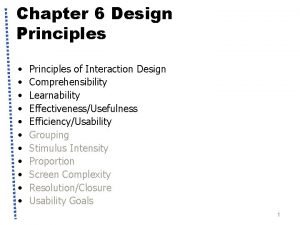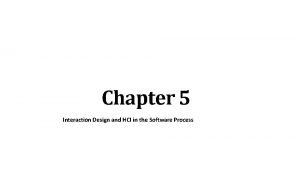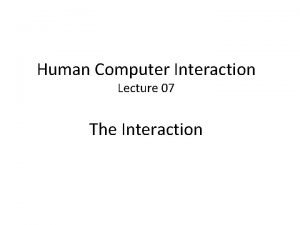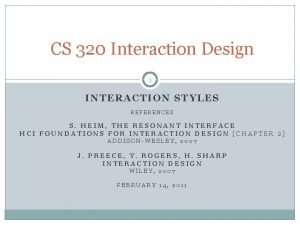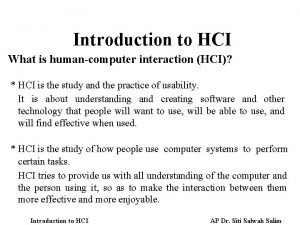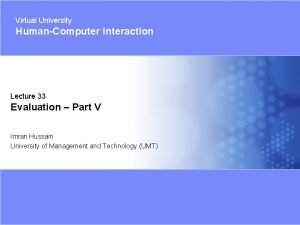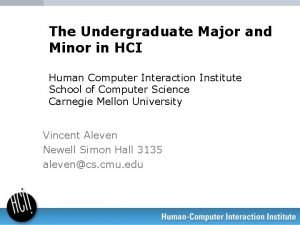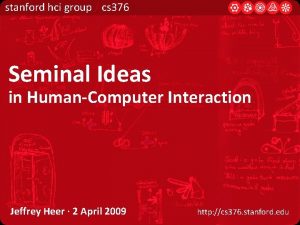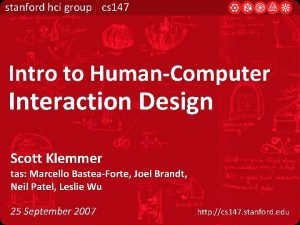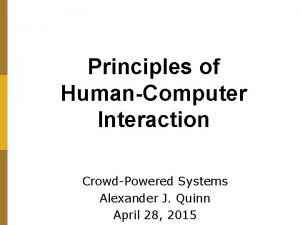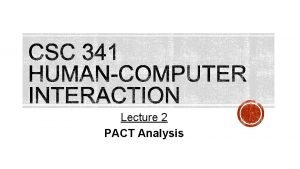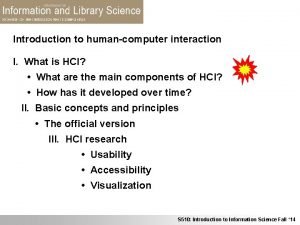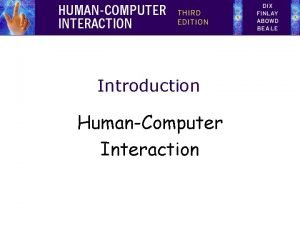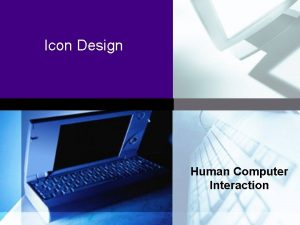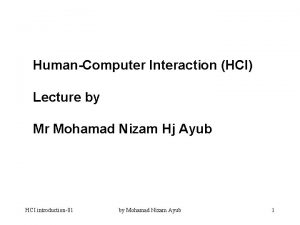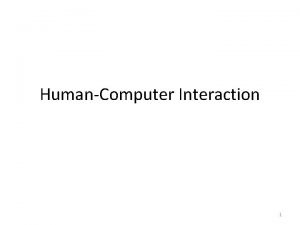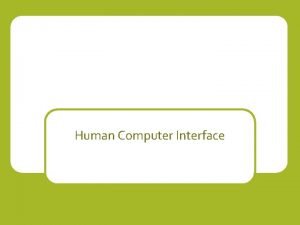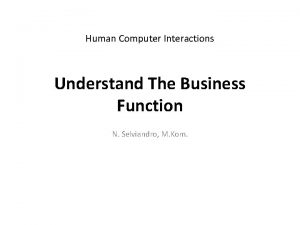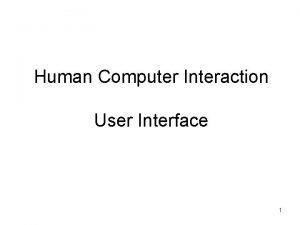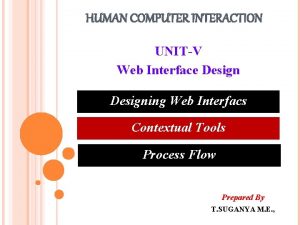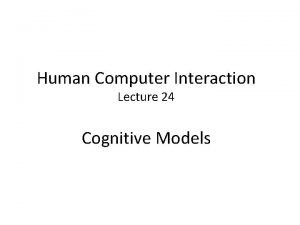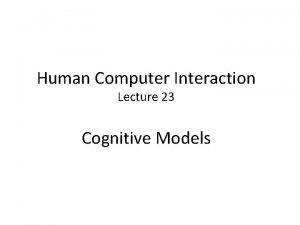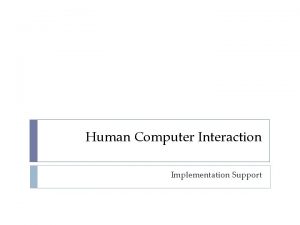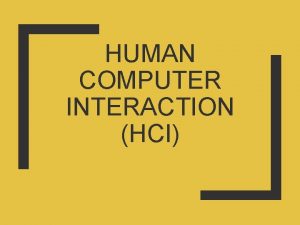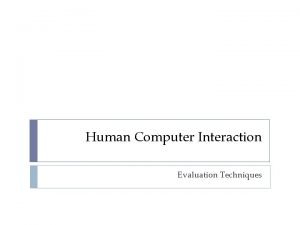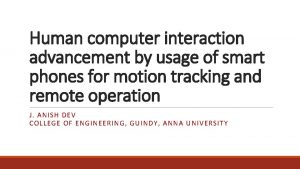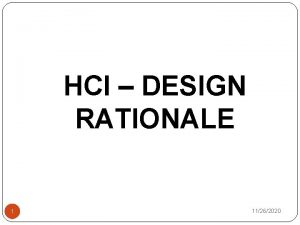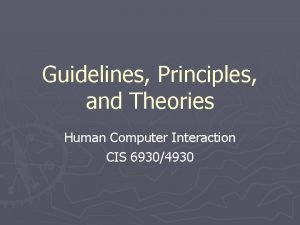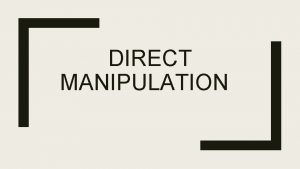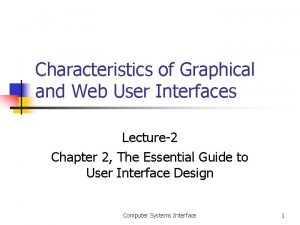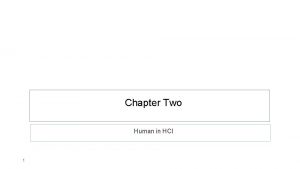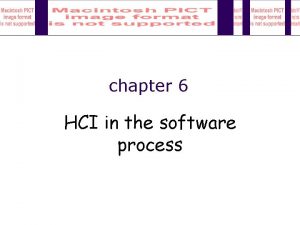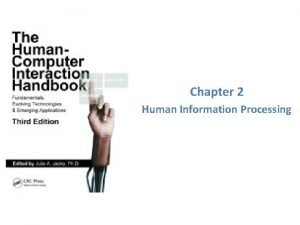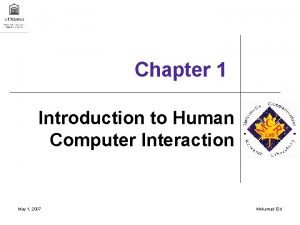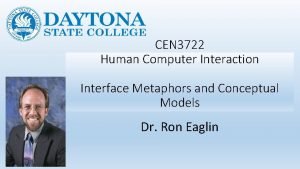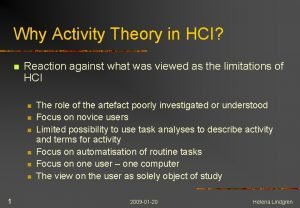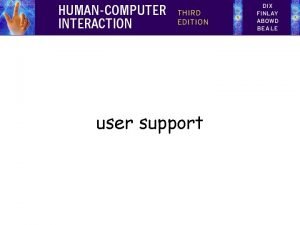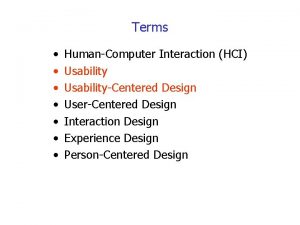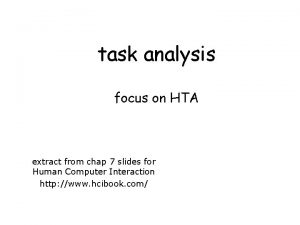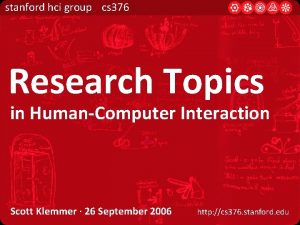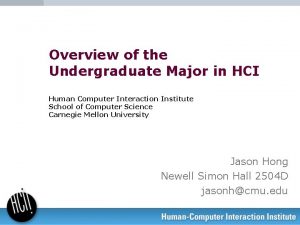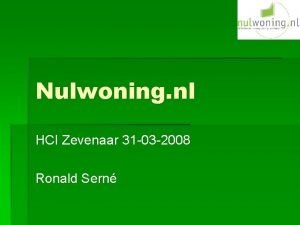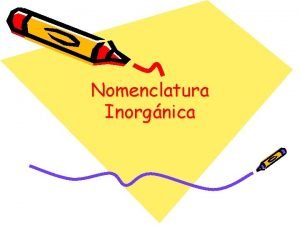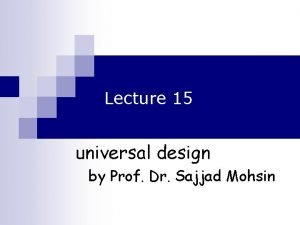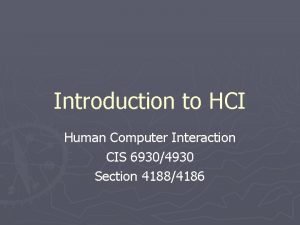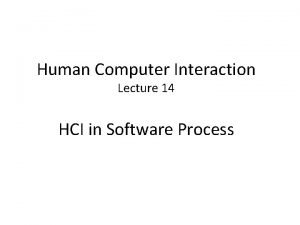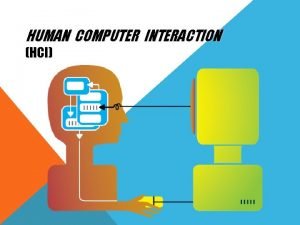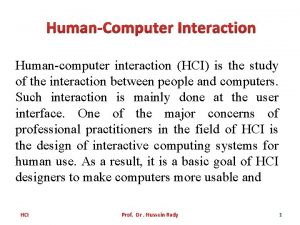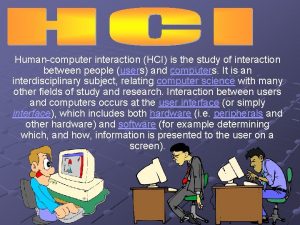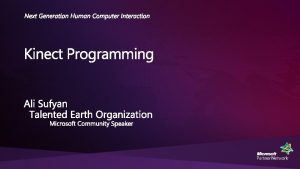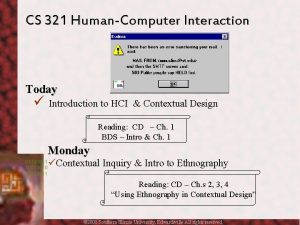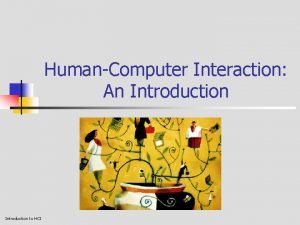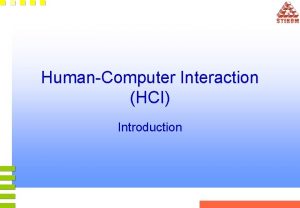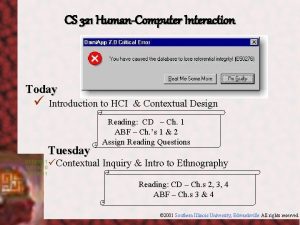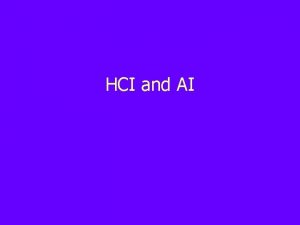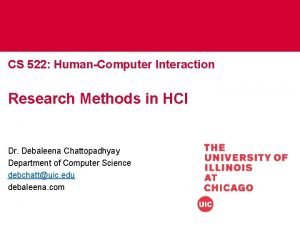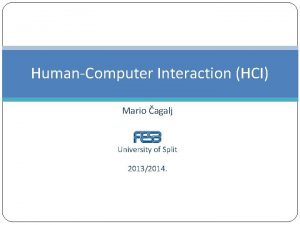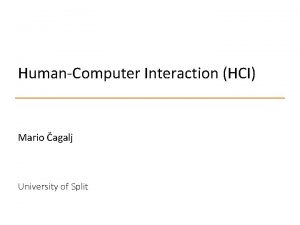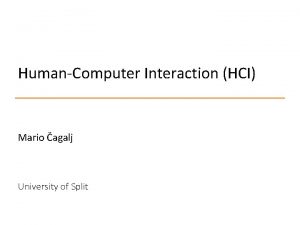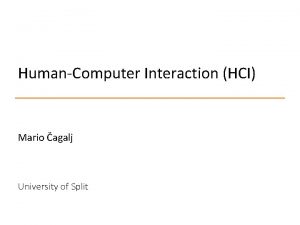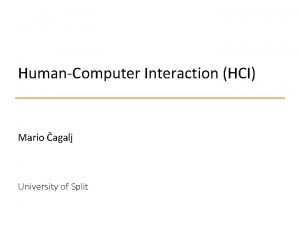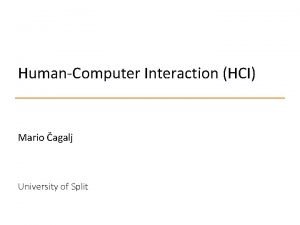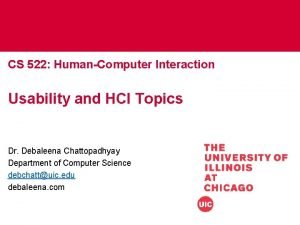Introduction to humancomputer interaction I What is HCI


































































- Slides: 66

Introduction to human-computer interaction I. What is HCI? • What are the main components of HCI? • How has it developed over time? II. Basic concepts and principles • The official version III. HCI research • Usability • Accessibility • Visualization S 510: Introduction to Information Science Fall ‘ 14

I. What is HCI? HCI is The study of the design, evaluation and implementation of interactive computing systems for human use and the major phenomena surrounding them It consists of three parts: the person, the computer, and the ways they work together Who is the “human” in HCI (the user)? A person with a laptop, a group working together or remotely, a series of people working in sequence… A person or persons trying to get a job done using technology S 510: Introduction to Information Science Fall ‘ 14

I. What is HCI? Who is the “human” in HCI (the user)? When studying the person, the focus is on physiology, cognitive psychology, and socio -technical action Physiology: ergonomics, human factors What is the range of physiological constraints when using ICTs? How should design take these into account? How small can a PDA keypad be and still be usable? Is this the best type of input device to design? www. pec-forum. com/terminali/palmari. htm S 510: Introduction to Information Science Fall ‘ 14

I. What is HCI? Who is the “human” in HCI (the user)? Cognitive psychology: understanding the ways in which thinking and reasoning play roles in our ICT use What is the role of sensory perception and memory in ICT use and how can this be incorporated into design? Improved legibility of hypertext (font, background colors) results in improved reading comprehension Distinguishable sounds indicate that a task has been successfully completed Interface design can take advantage of short term memory by providing appropriate stimuli for recall S 510: Introduction to Information Science Fall ‘ 14

I. What is HCI? What types of devices are included in “computer? ” Technologies range from grid and supercomputing to desktops, to mobile devices to embedded and pervasive computing Artifacts such as websites, computer games and car interiors Evolution of computing Computing to communication Machinery to habitat Aliens to agents S 510: Introduction to Information Science Fall ‘ 14

I. What is HCI? Evolution of computing Computing to communication www. kunrath. de/Nice_things_in_life/takeoff. gif mainframe. typepad. com/. shared/image. html? /photos/ uncategorized/2007/07/12/gijoe_5. jpg S 510: Introduction to Information Science Fall ‘ 14

I. What is HCI? Evolution of computing Machinery to habitat www. cs. colorado. edu/. . . /announcement. htm S 510: Introduction to Information Science Fall ‘ 14

I. What is HCI? Evolution of computing Machinery to habitat: another view images 20041028_korean_ www. unmediated. org/ wearables. jp www. muycomputerpro. com/ wp-content/uploads/2013/11/ google-glass-headset. jpg www. fitbit. com/flex money. cnn. com/2014/09/09/ technology/mobile/appleiphone-iwatch-event/ S 510: Introduction to Information Science Fall ‘ 14

I. What is HCI? Evolution of computing Machinery to habitat: another view It’s real! The Bristol Wearable Computing Project in 2002 wearables. cs. bris. ac. uk/public/images/ripleys 2004875520501. gif S 510: Introduction to Information Science Fall ‘ 14

I. What is HCI? Evolution of computing Machinery to habitat: still another view Ambient Wood (Rogers) www. sussex. ac. uk/. . . /11 jul 03/article 3. shtml www. hcibook. com/e 3/casestudy/ambient-wood/ S 510: Introduction to Information Science Fall ‘ 14

I. What is HCI? Evolution of computing Aliens to agents www. amsky. com/spaceflight/amsky/gort. jpg www. projectory. de/kaariboga usage/ distributed. Computing. gif www. afnet. fr/portail/news/05_e-trans/ 254_ etrans/aibo. jpg S 510: Introduction to Information Science Fall ‘ 14

I. What is HCI? Evolution of computing Aliens to agents: another view Agents in a collective communicate over secured links on the net or intranet Malicious agents (with horns) are detected and cut off from the collective Properly authenticated data are allowed in but bad data are rejected www. sandia. gov/. . . /software_story. html S 510: Introduction to Information Science Fall ‘ 14

I. What is HCI? What types of “interactions” matter? The directionality goes both ways: we initiate actions when using ICTs and respond to actions initiated by ICT Interactions have empirical features: Human/non-human interactants, beginnings and ends, turn-taking, iteration, use of power and control What is the range of interactions that occur when we use ICTs (particularly computing)? ICTs allow us to interact indirectly A medium through which we interact with each other and our environment that is transforming our lives S 510: Introduction to Information Science Fall ‘ 14

I. What is HCI? A focus on interaction moves HCI to a consideration of contextual awareness Context: a complex description of shared knowledge about physical, social, historical, or other factors within which an action or an event occurs To understand actions or events, it is necessary to have access to the relevant context in which actions and events occur Delivering information at appropriate times and places to allow people to more effectively run their lives Ex: pop-up reminders of what needs to be done, providing relevant information at a point in time S 510: Introduction to Information Science Fall ‘ 14

I. What is HCI? Knowledge of information behaviour and its relevance Hepworth argues that sociotechnical trends influence the development of ICTs towards “people-centered” design It is critically important to understand the complexity of people's information behaviors To promote better design, he proposes an ontology of information behavior research ~Do you agree with his idea of inclusion: “all people … are perceived to have a right to participate and … access products and services? ” ~Is the ontology sensible? Is anything left out? S 510: Introduction to Information Science Fall ‘ 14

I. What is HCI? The direction in computing and ICTs is towards peoplecentered design Trends: commodification of information; inclusion personalization; information overload; virtual learning environments A combination of social norms and technologies has led to a need to create usable electronic environments People want to become informed in effective ways The environment must respond to the complex cultural and psychological needs of the consumer Hepworth, M. (2007). Knowledge of information behaviour and its relevance to the design of people-centred information products and services. Journal of Documentation, 63(1), 33 S 510: Introduction to Information Science Fall ‘ 14

I. What is HCI? Hepworth argues for the importance of understanding people’s information behaviors Individual Cognitive needs Connative needs Affective needs Behavioral needs Local social Wider cultural S 510: Introduction to Information Science Fall ‘ 14

I. What is HCI? What are the overall goals of HCI? Design and develop devices and systems that are usable, efficient, and safe Create devices and systems that are “intuitive” and can be used with a minimum of change and disruption Another view: HCI seeks to make data exchange between people and ICT less stressful and less prone to misunderstandings This increases the efficiency of tasks that involve both the human and the computer www. bcs-hci. org. uk/hci 2006/ S 510: Introduction to Information Science Fall ‘ 14

I. What is HCI? HCI developed over time from computer graphics, human factors, ergonomics, industrial engineering, cognitive psychology, and the systems part of CS Work in computer graphics led to the development of HCI techniques Sutherland's 1963 Sketchpad Ph. D. thesis marked the beginning of computer graphics as a discipline Related work: a “man-machine symbiosis” (Licklider, 1960), “augmentation of human intellect” (Engelbart, 1963) Hewett et al. (1996). ACM SIGCHI Curricula for Human-Computer Interaction sigchi. org/cdg 2. html S 510: Introduction to Information Science Fall ‘ 14

I. What is HCI? This work led to important building blocks for HCI The mouse, bitmapped displays, personal computers, windows, the desktop metaphor, and point-and-click editors Baecker & Buxton, 1987, Chapter 1 Work on operating systems led to techniques for Interfacing input/output devices Tuning system response time to human interaction times Multiprocessing Supporting windowing environments and animation S 510: Introduction to Information Science Fall ‘ 14

I. What is HCI? Human factors comes from problems of designing equipment operable by humans during World War II These problems had strong sensory-motor features Ex: the design of flight displays and controls The problem of the human use of computers is an extension of classical human factors Ergonomics arose from studies of work Concerns tended to be at the sensory-motor level, with attention to physiology and an emphasis on stress Human interaction with computers was a natural topic for ergonomics S 510: Introduction to Information Science Fall ‘ 14

I. What is HCI? jimnolan. typepad. com/. a/ 6 a 00 e 5521 e 0 b 2 e 8833014 e 8 a 472 ac 8970 dpibad. eserver. org/issues/1999/45/ingrate 8. jpg 2. bp. blogspot. com/-9 NF 6 FGYZHKo/ Trd 0 RGzs. BLI/AAAAADM/CXPJoo. I 7 yd. I/ s 1600/Computer-Frustration-Mutual. Cartoon. jpg S 510: Introduction to Information Science Fall ‘ 14

I. What is HCI? Cognitive psychology derives from attempts to study sensation empirically in the late 1800 s 1950 s: psychologists were influenced by computer and communications and linguistics It became an experimentally-oriented discipline focused on human information processing and performance Main concern: structure, functioning, and limits of cognition and perception It focuses on the process of learning systems Transfer of learning, mental representation of systems, and human performance when using systems www. unicog. org/main/ pages. php? page=Research S 510: Introduction to Information Science Fall ‘ 14

I. What is HCI? Market pressures helped in the development of HCI The growth of discretionary computing and the mass personal and workstation computer markets Sales of computers are more tied to the quality of their interfaces than in the past The result: a gradual evolution of a standardized interface architecture It’s gone from hardware support of mice to shared window systems to “application management layers” HCI researchers and designers develop techniques for designing and testing interfaces S 510: Introduction to Information Science Fall ‘ 14

Introduction to human-computer interaction I. What is HCI? • What are the main components of HCI? • How has it developed over time? II. Basic concepts and principles • The official version III. HCI research • Usability • Accessibility • Visualization S 510: Introduction to Information Science Fall ‘ 14

II. Basic concepts and principles This is the ACM’s model of the content of HCI N The Nature of HCI N 1 (Meta-)Models of HCI U Use and Context of Computers U 1 Human Social Organization and Work U 2 Application Areas U 3 Human-Machine Fit and Adaptation H Human Characteristics H 1 Human Information Processing H 2 Language, Communication, Interaction H 3 Ergonomics C Computer System and Interface Architecture C 1 Input and Output Devices C 2 Dialogue Techniques C 3 Dialogue Genre C 4 Computer Graphics C 5 Dialogue Architecture D Development Process D 1 Design Approaches D 2 Implementation Techniques D 3 Evaluation Techniques D 4 Example Systems and Case Studies P Project Presentations and Examinations Hewett et al. sigchi. org/cdg 2. html#2_2_1 S 510: Introduction to Information Science Fall ‘ 14

II. Basic concepts and principles Hewett et al. sigchi. org/cdg 2. html#2_2_1 S 510: Introduction to Information Science Fall ‘ 14

II. Basic concepts and principles Usability: a quality attribute used to assess how easy user interfaces are to use Methods to improve ease-of-use during design Nielsen, J. (2003). Usability 101: Introduction to usability. www. useit. com/alertbox/20030825. html Different views of usability www. usability. gr. jp/alertbox/ Product oriented: measuring product ergonomics User oriented: measuring mental attitude User-performance: measuring acceptability or ease of use (or both) Bevan et al. (1991). What is Usability. www. usability. serco. com/papers/whatis 92. pdf S 510: Introduction to Information Science Fall ‘ 14

II. Basic concepts and principles ISO 9241 -11: Guidance on Usability (1998): defines usability for use in related standards The extent to which a product can be used by specified users to achieve specified goals with effectiveness, efficiency and satisfaction in a specified context of use Identifies information to specify or evaluate usability with measures of user performance and satisfaction How to describe product’s context of use and usability measures in an explicit way How product usability can be specified and evaluated as part of a quality system www. usabilitynet. org/tools/r_international. htm#20282 http: //www. w 3. org/2002/Talks/0104 -usabilityprocess/usability S 510: Introduction to Information Science Fall ‘ 14

II. Basic concepts and principles New: an ISO standard for web usability ISO/AWI 23973 “Software ergonomics for World Wide Web user interfaces” The process domain www. userfocus. co. uk/articles. ISO 23973. html ISO 13407: 1999 Human-centered design processes for interactive systems The evaluation domain Tools and techniques to assess final design (usability) The design domain Where the designer develops the website S 510: Introduction to Information Science Fall ‘ 14

II. Basic concepts and principles It will provide guidance in four areas: 1. Purpose and strategy What is the purpose of the site? How is this made clear to its users? 2. Content and functionality What is the site’s conceptual model? How is content organized? How should the site deal with issues such as privacy and personalization? S 510: Introduction to Information Science Fall ‘ 14

II. Basic concepts and principles 3. Navigation and interaction How should content be organized so that users can navigate the site easily? How will users search the content of the site? 4. Presentation and media design How should individual pages be designed so people can make use of the information? How should multimedia be used? ISO is developing a standard for accessibility: ISO/AWI 16071: “Ergonomics of human-system interaction Guidance on software accessibility” S 510: Introduction to Information Science Fall ‘ 14

Introduction to human-computer interaction I. What is HCI? • What are the main components of HCI? • How has it developed over time? II. Basic concepts and principles • The official version III. HCI research • Usability • Accessibility • Visualization S 510: Introduction to Information Science Fall ‘ 14

III. HCI research Determinants of usability Usability: an approach to product development that incorporates direct user feedback throughout the development cycle to reduce costs and create products and tools that meet user needs Usability Professionals’ Association. (2004). What is usability? www. upassoc. org/usability_resources/about_usability/definitions_of_usability. html Product attributes Org/social context Product attributes of which user is aware Environmental Context Attitude Performance with product Understanding, mental effort Task S 510: Introduction to Information Science Fall ‘ 14

III. HCI research Usability has five quality components: Ease of learning: how easy is it to accomplish basic tasks the first time people use the system? Efficiency of use: once used to it, how quickly can they perform tasks? Memorability: how easy is it to reestablish proficiency? Error frequency: how many, how severe, recovery? Subjective satisfaction: how much do they like using it? Usability. gov (2013). User Experience Basics. www. usability. gov/what-and-why/user-experience. html Nielsen, J. (2003). Usability 101: Introduction to usability. www. useit. com/alertbox/20030825. htm S 510: Introduction to Information Science Fall ‘ 14

III. HCI research Some distinguish between usability engineering and testing Usability engineering: a methodical approach to producing a Web site or user interface A practical and systematic way to deliver a product that works for users Involves several methods, applied at appropriate times Gathering requirements, developing and testing prototypes, evaluating design alternatives, analyzing usability problems, proposing solutions, user testing Usability. gov (2013). Methods. www. usability. gov/how-to-and-tools/methods/index. html S 510: Introduction to Information Science Fall ‘ 14

III. HCI research Distinctions Testing is part of the process of usability engineering Methods where users try out a site or system Users perform a variety of tasks with a prototype while observers collect data about what users do and say Collecting data on the paths taken to do tasks, errors made, when and where users are confused, how fast they do a task, whether they succeed, and satisfaction Goal: to uncover problems that users may encounter so those problems can be fixed Usability. gov (2013). Methods. www. usability. gov/how-to-and-tools/methods/index. html S 510: Introduction to Information Science Fall ‘ 14

III. HCI research Heuristic evaluation (inspection): created in 1990 by Nielsen and Molich Faster and less expensive A predefined set of standards is given numeric scores by experts who role-play a specific visitor scenario They review a product or product design and present a marked checklist of problems to the designer 5 -10 could identify 55 -90% of known usability problems A cheap and inductive substitute for user testing Hollingsed, T. and Novick, D. G. (2007). Usability inspection methods after 15 years of research and practice. Proceedings of the 25 th annual ACM international conference on Design of communication. 249 -255 S 510: Introduction to Information Science Fall ‘ 14

III. HCI research Examples of heuristic evaluation criteria: Visibility of system status Error prevention Match between system and real world Help and documentation Consistency and standards User control and freedom Recognition rather than recall Flexibility and efficiency of use Aesthetic and minimalist design Help users recognize, diagnose, and recover from error S 510: Introduction to Information Science Fall ‘ 14

III. HCI research Research comparing heuristic evaluation to other methods found mixed results It uncovered more problems but other methods found more severe recurring, and global problems Comparing novices, usability experts, and usability domain experts, the two sets of experts reported the same number of problems in all areas other than the specific problems for the specific type of interfaces But it is hard and costly to round up experts If the experts are in house, it can be a cheaper and easier way to find some problems S 510: Introduction to Information Science Fall ‘ 14

III. HCI research Cognitive walkthrough: an inspection method to evaluate user interface design for ease of exploratory learning Focus on cognition - thought processes, decision making, memory, reasoning Done at any stage using a prototype, design document, or final product Based on perceptions of users’ goals, evaluators step through tasks How difficult it is to identify and operate the interface element most relevant to current subgoal How clearly does the system provide feedback? S 510: Introduction to Information Science Fall ‘ 14

III. HCI research Pluralistic usability walkthrough Incorporates representative users, product developers members of the product team, and usability experts The application’s screens appear in the same order as they would appear to the user All participants are asked to assume the role of the user They write down what actions they, as users, would take for each screen before the group discusses the screens When discussing each screen, representative users speak first S 510: Introduction to Information Science Fall ‘ 14

III. HCI research Benefits include: use early in design cycle, enabling rapid iteration of the design cycle, allowing “on-the-fly” redesign Three experts focusing on a different set of usability issues, led to a 30% improvement for both individual inspectors and as a group Advantage of perspective-based ability inspection Problem: it is a representative and not a comprehensive view of the application or site Seems to be used frequently by professionals S 510: Introduction to Information Science Fall ‘ 14

III. HCI research Formal usability inspections: a review by the interface designer and peers of users’ potential task performance Because reviewers are HCI experts, the review is quicker, more thorough, and more technical than the pluralistic walkthrough Goal: to identify the maximum number of defects in the interface as efficiently as possible It gains speed at the cost of losing multiple stakeholder perspectives of the pluralistic walkthrough Its cognitive model can be seen as less comprehensive than that of the cognitive walkthrough S 510: Introduction to Information Science Fall ‘ 14

III. HCI research Field usability testing Naturalistic observation of participants in workplaces, homes, schools, social spaces etc. Focus is on “normal behavior” when using ICT Provides insight into goals, needs, activities Contextual inquiry: when this is done in large organizations Participants as partners with researchers Driven by set of concerns (not specific questions) S 510: Introduction to Information Science Fall ‘ 14

III. HCI research Contextual evaluation: an approach to usability that focuses on the uses of ICT in real world settings Also on the problems that arise as people use the ICTs Assumes systems embody ways of working Functions and structures force workers to accept strategies, language, and work flow Assumes a shared understanding of work and system Challenge: to design a system to work within workers’ and organizational constraints and resolve as many of the problems as possible Mc. Donald, S. , Monahan, K. , and Cockton, G. (2007). Modified contextual design as a field evaluation method. Nord. CHI 2006. 14 -18. S 510: Introduction to Information Science Fall ‘ 14

III. HCI research Dimensions of usability ISO: the extent to which a product can be used by specified users to achieve specified goals with effectiveness, efficiency, and satisfaction in a specified context of use Nielsen: learnability, efficiency, memorability, low error rate or easy error recovery, and satisfaction Booth: usefulness, effectiveness (ease of use), learnability, and attitude (likeability) Hix and Hartson: initial and long-term performance, learnability, retainability, advanced feature usage, first impression, and long-term user satisfaction S 510: Introduction to Information Science Fall ‘ 14

III. HCI research Usability evaluation model: effectiveness, efficiency, and satisfaction Effectiveness: whether the system as a whole can provide information and functionality effectively Measured by number of correct answers Efficiency: the system’s ability to retrieve information Measured by time to complete tasks Satisfaction: ease of use, organization of information, clear labeling, visual appearance, contents, and error corrections Measured by Likert scales and questionnaires S 510: Introduction to Information Science Fall ‘ 14

III. HCI research Other variables Ease of use: user perceptions of ease of use Organization of information: whether structure, layout, and organization is satisfying to the user Labeling: perception of clarity of labeling and of terminology Visual appearance: perception of site design aesthetics Content: perception of authority and accuracy of information provided Error: tests whether users recover from mistakes easily and if mistakes occur due to system design S 510: Introduction to Information Science Fall ‘ 14

III. HCI research Includes a pretest questionnaire, a list of tasks, and a post-test questionnaire Locate known items, including author, title, and -book searching e Use databases to find articles in electronic journals Locate information, such as eligibility for ILL services and how to set up remote access Jeng (2013; 52) S 510: Introduction to Information Science Fall ‘ 14

III. HCI research Usability: Lessons learned … and yet to be learned The author provides a critical overview of major developments in usability research and practice The focus is on types of usability, the appropriate methods for data gathering and the most useful approach to sample size issues. ~ Why is it important to distinguish between summative and formative usability? ~ What are the advantages of standardized usability questionnaires? S 510: Introduction to Information Science Fall ‘ 14

III. HCI research Usability: an emergent property dependent on interactions among users, products, tasks, and environments Summative usability: focus on metrics associated with meeting global task and product goals (measurementbased) Focused on metrics of effectiveness and efficiency in the context of use A product is usable when people can use it for its intended purpose effectively, efficiently, and with a feeling of satisfaction Lewis, J. R. (2014) Usability: Lessons Learned … and Yet to Be Learned, International Journal of Human-Computer Interaction, 30: 9, 663 -684 S 510: Introduction to Information Science Fall ‘ 14

III. HCI research Formative : focus on detection of problems and design of interventions to reduce or eliminate their impact (diagnostic-based) Building, checking to see where it could be improved, improving it, trying again (design–test–redesign–retest) Empirical: standard formative usability testing, with or without the think-aloud and contextual evaluations Inspection: expert and heuristic evaluations Also other structured protocols such as GOMS (goals, operators, methods, selection), card sorting and cognitive walkthroughs S 510: Introduction to Information Science Fall ‘ 14

III. HCI research Key lessons learned It is important to distinguish between the goals and practices of summative and formative usability Iterative formative usability testing seems effective in improving both objective and perceived usability It is permissible to average multipoint scale ratings, but interpret the results carefully Practitioners should use one or more standardized usability questionnaires They should use available tools to guide sample size estimation rather than relying on magic numbers S 510: Introduction to Information Science Fall ‘ 14

III. HCI research Usability and accessibility in consumer health informatics: Current trends and future challenges Goldberg et al. argue that user centered design is critical in the development of health information systems, given the trend toward electronic personal health records They describe Lifelines 2, a HIT system, and explain how the Federal government is attempting to shape HCI research in this area ~What challenges do you see in developing PHR systems? ~What types of usability standards would be most important in designing HIT that consumers can use? S 510: Introduction to Information Science Fall ‘ 14

III. HCI research e. Health systems have value and impact when they are usable and accessible by clinicians, consumers, and other stakeholders Challenges: to design systems powerful enough to handle the volume and complexity of medical data Also: support patients and professionals in their work Problem: developers work in environments that make it diffıcult to have a connection to the context in which their work will be used Goldberg, L. , Lide, B. , Lowry, S. , Massett, H. A. , O'Connell, T. , Preece, J. , Quesenbery, W. and Shneiderman, B. (2011). Usability and Accessibility in Consumer Health Informatics: Current Trends and Future Challenges. American Journal of Preventive Medicine, 40(5), S 187 -S 197 S 510: Introduction to Information Science Fall ‘ 14

III. HCI research Their approach assumes that people who use a system must be seen as individuals in a context of use Usability is a quality of the product, but is defıned in the terms of the people using it Accessibility is usability for a broader group of people those with the widest range of capabilities All users should have an equivalent experience no matter what assistive technology, computer or mobile device they use Usability and accessibility must be considered from the very beginning of a project S 510: Introduction to Information Science Fall ‘ 14

III. HCI research Their “reader-to-leader” framework is designed to help researchers, designers, and managers understand motivations to participate in social media Can improve user-interface design and social support for projects Assumption: individuals’ needs and characteristics initially shape interface designs and social requirements determine the nature of CMC Every social system must have away to establish community norms and explicit policies to survive Successive levels of social participation: reading, contributing, collaborating, and leading S 510: Introduction to Information Science Fall ‘ 14

III. HCI research Computerized PHRs pose tremendous problems for designers PHRs are information-rich, but challenging to analyze because of qualitative data, such as complaints, diagnoses, and treatments Typically outside the scope of standard statistical tools Poorly designed user interfaces that require horizontal scrolling, clumsy searches, endless menus, and chaotic layouts will be replaced by compact designs with clear layouts Patients will become increasingly comfortable in using web-based services S 510: Introduction to Information Science Fall ‘ 14

III. HCI research Lifelines 2: a one-screen overview of PHRs using timelines to provide direct access to data An interactive tool for visualizing temporal categoric data across multiple records To enable discovery and exploration of patterns across records to support hypothesis generation, and fınding cause-and-effect relationships in a population Goal: to encourage development and adoption of interoperable standards, specifıcations, systems, and services To identify, fılter, and present content in ways useful to people with a wide variety of specifıc needs S 510: Introduction to Information Science Fall ‘ 14

III. HCI research Realistic electronic books Liesaputran and Witten describe an ebook interface, Realistic Books, that they claim addresses many of the problems that have plagues ebook readers They conducted usability testing to support their claim that their approach is the most likely to lead to ebook readers that people will want to use ~ Will ebook readers replace physical books? Why not? ~Do you like this interface? What would you ask the designers to incorporate into this system? S 510: Introduction to Information Science Fall ‘ 14

III. HCI research Manufacturers compete to produce light mobile ereaders, with high resolution displays and other features But the underlying document representation nor interaction with ebooks has not evolved significantly Current edocument systems offer added value over paper books Authors can revise information and incorporate links and multimedia, and readers have full-text search However, they fail to provide adequate cues about the location in a document, and do not support interactions without disrupting the ongoing reading activity Liesaputra, V. and Witten, I. H. (2012). Realistic electronic books. International Journal of Human-Computer Studies, 70(9), 588 -610 S 510: Introduction to Information Science Fall ‘ 14

III. HCI research Is it is necessary to emulate the physical book? It is clear that the book metaphor is powerful Background: reading is embedded within many other document-based activities Reader engagement: passive (entertainment) and active (thinking, learning and decision making) reading Question: why are physical book models not more widely used in digital libaries? Goal: developing ereaders that are affordable, portable, durable, easy to use, readable, comfortable, with storage and long battery life, net-ready, with support for I/O (keyboard, stylus and gesture) S 510: Introduction to Information Science Fall ‘ 14

III. HCI research Realistic books: combine the advantages of physical and edocuments A Flash app with a complex interface (book space, reader's tools, preview area) that models a physical book Bookmarks and annotations allow personalization Reader aids include navigational hyperlinks, definition popups using Wikipedia, synonmyns, back-of-the-index Provide context and orientation clues through the table of contents, typographic cues, running heads, page numbers, page edges and bookmark tabs Has a search function where hits are indicated by tabs S 510: Introduction to Information Science Fall ‘ 14

III. HCI research Realistic books interface Liesaputran and Witten, 597 S 510: Introduction to Information Science Fall ‘ 14

III. HCI research A task-based scheme was used for a user-centered evaluation based on a series of hypotheses Subjects preferred Realistic Books over other formats, and completed tasks significantly faster Liked automatically generated back of the book index, full text searching and bookmarked chapter and section openings Used visual landmarks surrounding text for orientation When these cues were removed participants felt lost, disoriented and frustrated Fluid interaction between browsing, searching and personalizing led to a more pleasant experience S 510: Introduction to Information Science Fall ‘ 14
 Hci interaction styles
Hci interaction styles Norman's model of interaction in hci
Norman's model of interaction in hci Modeling rich interaction in hci
Modeling rich interaction in hci Batch processing in hci
Batch processing in hci History of human computer interaction
History of human computer interaction Interaction framework in hci
Interaction framework in hci Interaction styles in hci
Interaction styles in hci Emotional interaction
Emotional interaction Flight level
Flight level Elements of wimp interface in hci
Elements of wimp interface in hci Interaction styles in hci
Interaction styles in hci Hci
Hci Trunk test in hci
Trunk test in hci Hci classification
Hci classification Cmu hci minor
Cmu hci minor Stanford hci group
Stanford hci group Cs 147 stanford
Cs 147 stanford Principles of robustness in hci
Principles of robustness in hci Principles of hci
Principles of hci Hci consists of three parts:
Hci consists of three parts: Hci life cycle model
Hci life cycle model Pact analysis of website example
Pact analysis of website example What is hci
What is hci Hci science
Hci science Icon based logo
Icon based logo In hci
In hci Hci definition
Hci definition User interface uses the fewest system resources:
User interface uses the fewest system resources: Basic business functions in hci
Basic business functions in hci Task conformance in hci
Task conformance in hci Process flow of web interface design in hci
Process flow of web interface design in hci Task action grammar is based upon bnf
Task action grammar is based upon bnf Cognitive complexity theory hci
Cognitive complexity theory hci What is implementation support in hci
What is implementation support in hci Input-output channels in hci
Input-output channels in hci Constraints in hci example
Constraints in hci example Automated analysis in hci
Automated analysis in hci Hci
Hci Norman's 7 principles in hci
Norman's 7 principles in hci Hci patterns
Hci patterns Krmar ladje argonavtov
Krmar ladje argonavtov Permit easy reversal of actions
Permit easy reversal of actions Direct manipulation hci
Direct manipulation hci Graphical characteristics
Graphical characteristics Physical reception of stimulus
Physical reception of stimulus Elements of windowing system in hci
Elements of windowing system in hci Usability specification in hci
Usability specification in hci Human information processing hci
Human information processing hci Components of hci
Components of hci Hci chapter 1
Hci chapter 1 Metaphors in hci
Metaphors in hci Engestrom activity system model
Engestrom activity system model User support examples
User support examples Balancing function and fashion in hci
Balancing function and fashion in hci Hci adalah
Hci adalah Hci terms
Hci terms Textual hta
Textual hta Stanford hci group
Stanford hci group Hci major
Hci major Hci zevenaar
Hci zevenaar Hci nomenclatura
Hci nomenclatura Speech digitization and generation in hci
Speech digitization and generation in hci Define universal design in hci
Define universal design in hci Common device with substantial hci design
Common device with substantial hci design It overcomes inherent problems of incomplete requirements
It overcomes inherent problems of incomplete requirements Screen design and layout in hci
Screen design and layout in hci Definition of human computer interaction
Definition of human computer interaction
